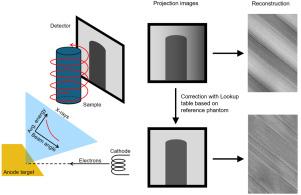Correction for the heel effect in helical μCT scans for accurate densitometry
IF 3.7
2区 工程技术
Q2 ENGINEERING, MANUFACTURING
Precision Engineering-Journal of the International Societies for Precision Engineering and Nanotechnology
Pub Date : 2025-07-03
DOI:10.1016/j.precisioneng.2025.06.019
引用次数: 0
Abstract
In most conventional X-ray tubes, the anode target is tilted with respect to the optical axis of the measurement system. However, the tilt causes a spatial variation of the X-ray spectrum throughout the generated X-ray beam, a spatio-spectral effect called the (anode) heel effect. Since the sample in a micro computed tomography (CT) scan experiences an asymmetry in the X-ray beam spectrum due to the heel effect, the projection images will contain an asymmetry as well. This influences the resulting reconstructions from the CT scan. As a consequence, the heel effect hinders an accurate determination of local material densities with CT, particularly when using a helical trajectory. In this paper, a method will be demonstrated that is capable of correcting for the heel effect in helical CT scans where the heel effect is oriented perpendicular to the rotation axis. This increases the accuracy of the obtained local mass densities. In addition, the method removes beam hardening effects. The method is based on a lookup table (LUT) that is used to correct pixel values in the normalised projection images of the CT scan in order to eliminate the asymmetry introduced by the heel effect. We demonstrate this correction algorithm on a helical CT scan of wood increment cores, which sufficiently satisfies the method’s requirement of a homogeneous chemical composition. Nonetheless, the method can be used in a wide variety of applications.

校正螺旋μCT扫描中精确密度测量的脚跟效应
在大多数传统的x射线管中,阳极靶相对于测量系统的光轴是倾斜的。然而,倾斜导致整个生成的x射线束的x射线光谱的空间变化,一种称为(阳极)脚跟效应的空间光谱效应。由于微计算机断层扫描(μCT)中的样品由于脚跟效应而在x射线波谱中经历不对称,因此投影图像也将包含不对称。这影响了μCT扫描的重建结果。因此,脚跟效应阻碍了μCT对局部材料密度的精确测定,特别是在使用螺旋轨迹时。本文将演示一种能够校正螺旋μCT扫描中脚跟效应的方法,其中脚跟效应垂直于旋转轴。这增加了获得的局部质量密度的准确性。此外,该方法消除了梁硬化效应。该方法基于查找表(LUT),用于校正μCT扫描的归一化投影图像中的像素值,以消除由脚跟效应引入的不对称性。我们在木材增量岩心的螺旋μCT扫描上验证了这种校正算法,它充分满足了该方法对化学成分均匀性的要求。尽管如此,该方法可用于各种各样的应用。
本文章由计算机程序翻译,如有差异,请以英文原文为准。
求助全文
约1分钟内获得全文
求助全文
来源期刊
CiteScore
7.40
自引率
5.60%
发文量
177
审稿时长
46 days
期刊介绍:
Precision Engineering - Journal of the International Societies for Precision Engineering and Nanotechnology is devoted to the multidisciplinary study and practice of high accuracy engineering, metrology, and manufacturing. The journal takes an integrated approach to all subjects related to research, design, manufacture, performance validation, and application of high precision machines, instruments, and components, including fundamental and applied research and development in manufacturing processes, fabrication technology, and advanced measurement science. The scope includes precision-engineered systems and supporting metrology over the full range of length scales, from atom-based nanotechnology and advanced lithographic technology to large-scale systems, including optical and radio telescopes and macrometrology.

 求助内容:
求助内容: 应助结果提醒方式:
应助结果提醒方式:


